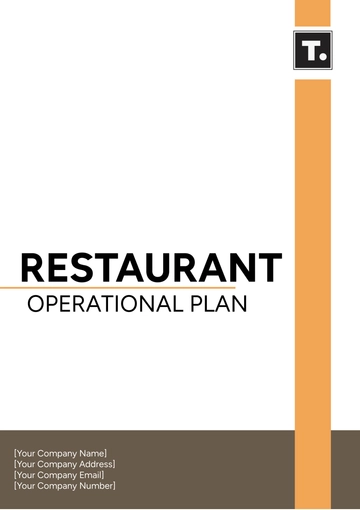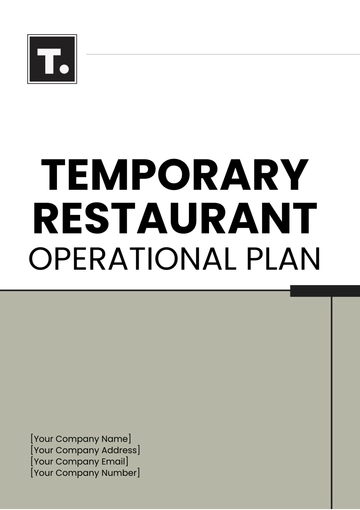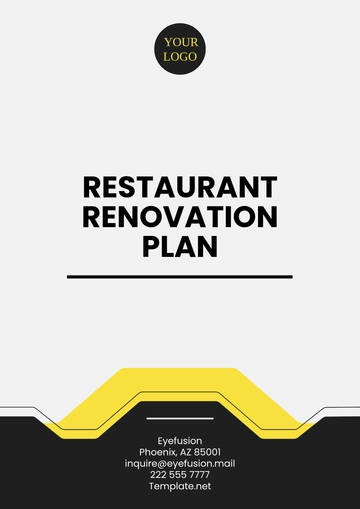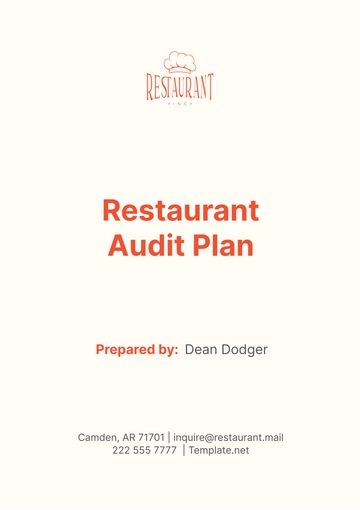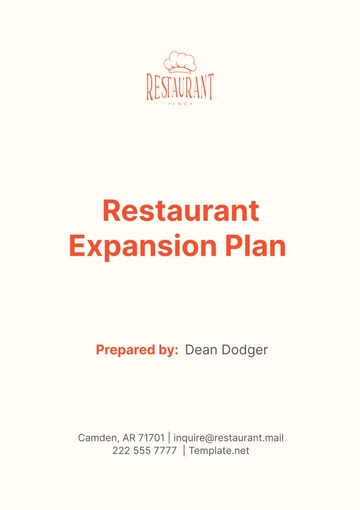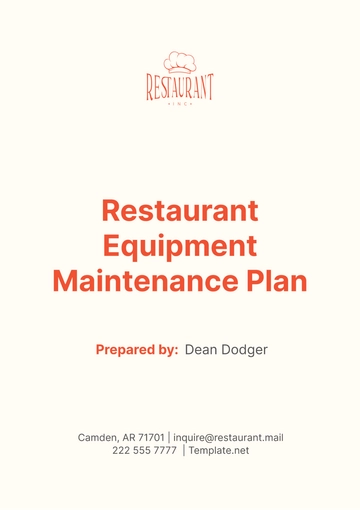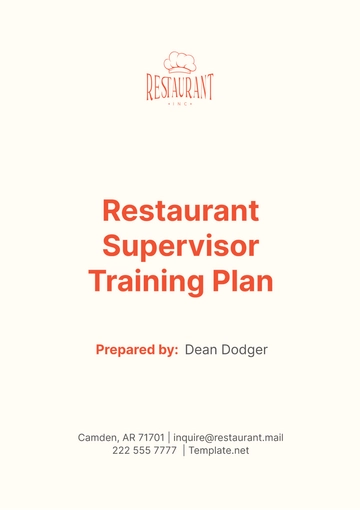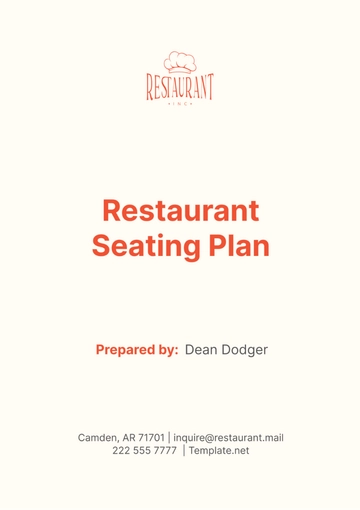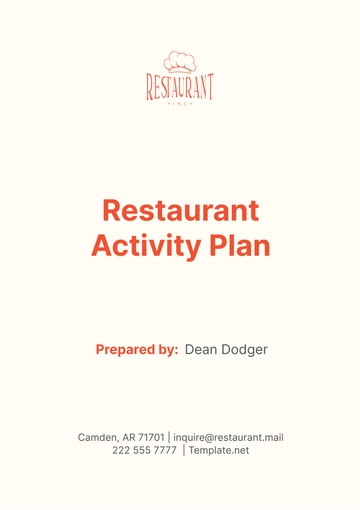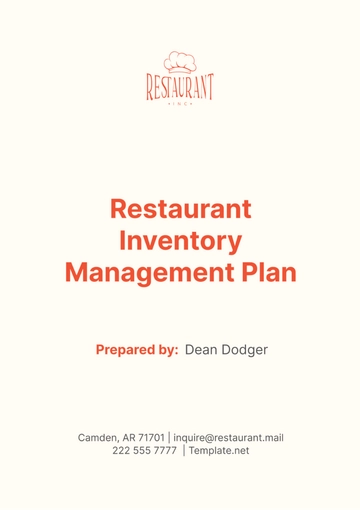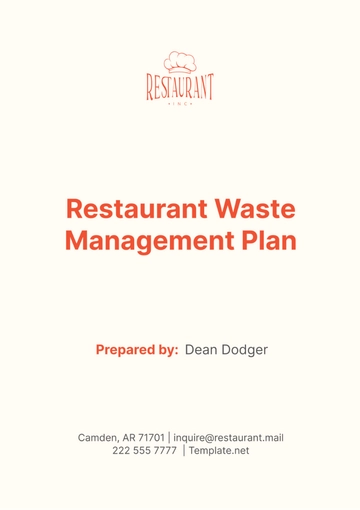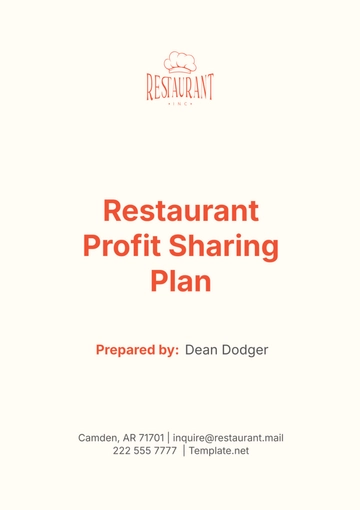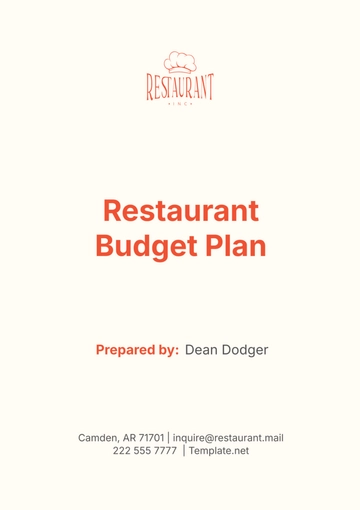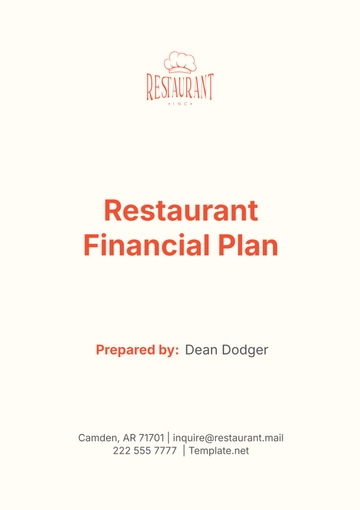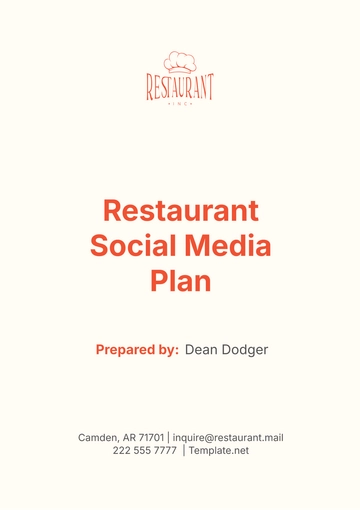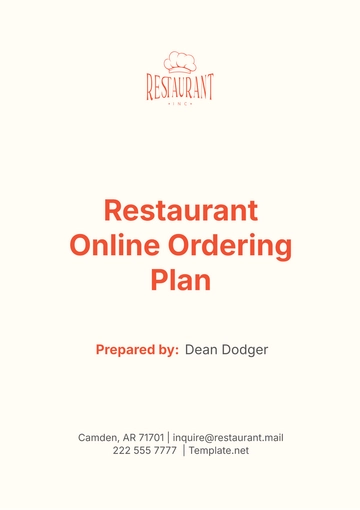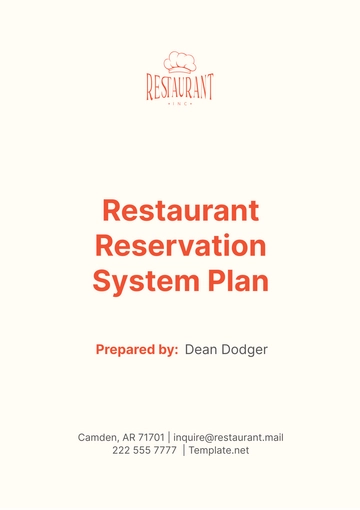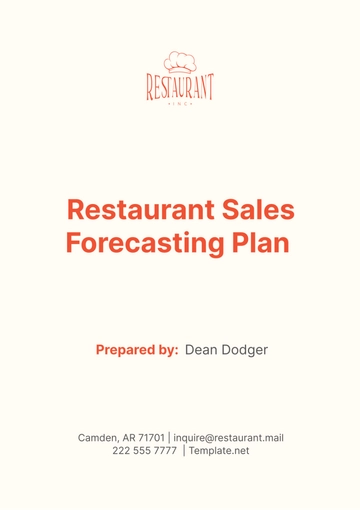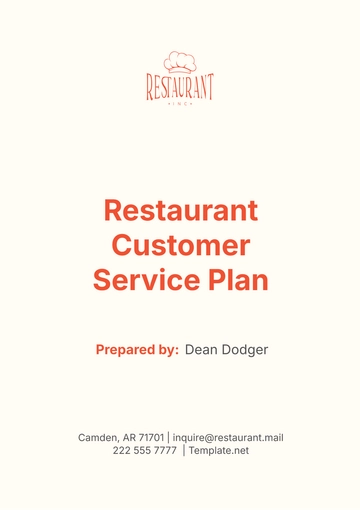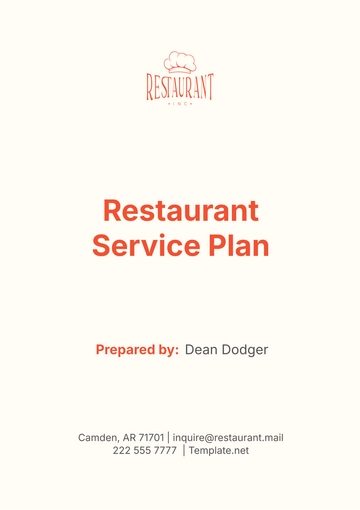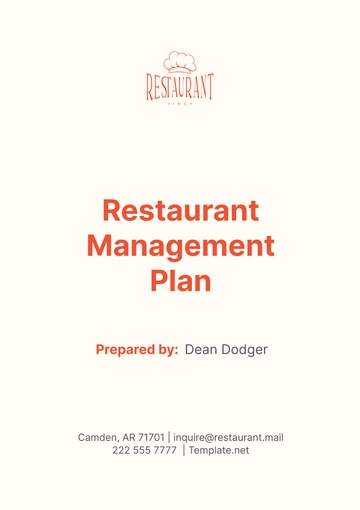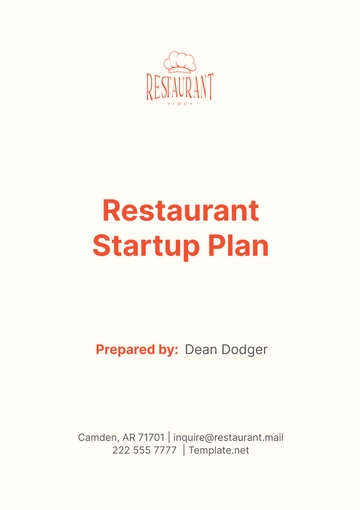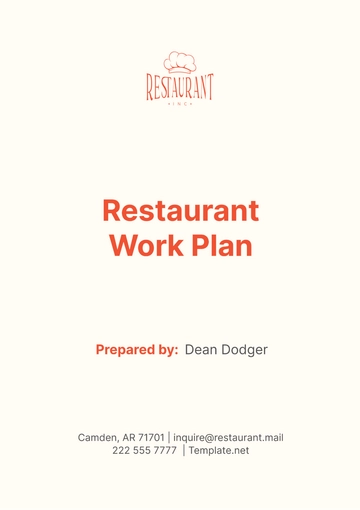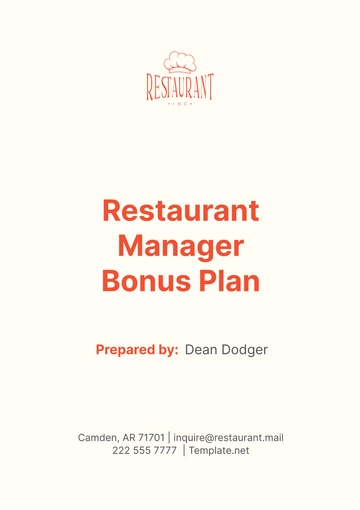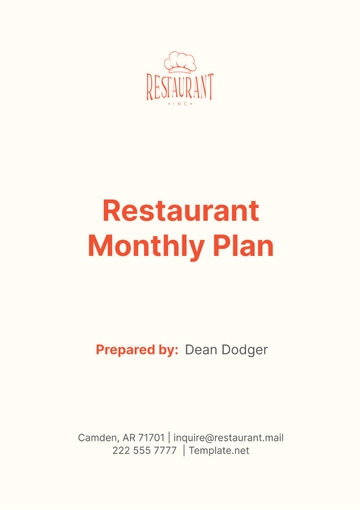Free Restaurant Work Plan
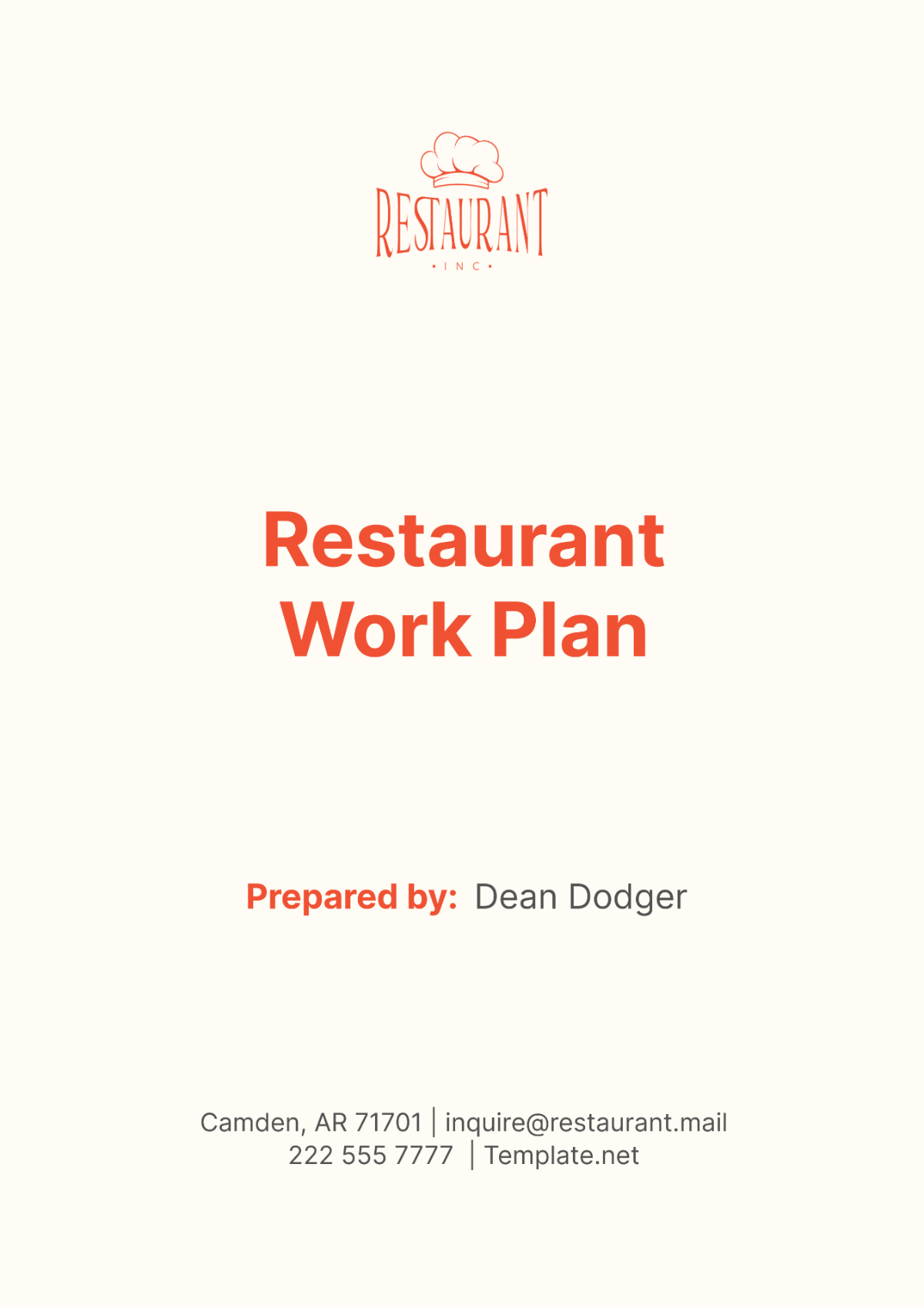
I. Introduction
The Work Plan presented here is a comprehensive blueprint designed to guide [Your Company Name] in the successful introduction of our new services. This plan is meticulously crafted to ensure that every step we take contributes to our ultimate goal: enhancing efficiency and customer satisfaction through structured planning and implementation.
A. Objective
The primary objective of this Work Plan is not just to introduce our new restaurant services, but to do so in a systematic and efficient manner. We aim to ensure that all staff are adequately trained, effective marketing strategies are implemented, and all necessary operational adjustments are smoothly operationalized.
Systematic Introduction: Our approach to introducing new services is systematic, meaning we follow a well-defined process that ensures every aspect of the rollout is carefully planned and executed.
Staff Training: We understand the importance of having well-trained staff. Therefore, we have included comprehensive training programs in our plan to ensure our staff are equipped with the necessary skills and knowledge to deliver our new services effectively.
Marketing Strategies: We believe that effective marketing is key to the successful introduction of our new services. Our plan includes innovative marketing strategies designed to create awareness and generate interest in our new offerings.
Operational Adjustments: Introducing new services often requires adjustments to our operations. Our plan includes strategies for smoothly implementing these adjustments to ensure minimal disruption to our existing services.
B. Scope of Work
This Work Plan covers a broad spectrum of key areas, each of which plays a vital role in the successful rollout of our new services:
New Menu Development: This involves researching and developing new dishes that align with our brand and appeal to our customers. We will also be conducting taste tests and refining our dishes based on feedback.
Staff Training and Development: Our staff are our most valuable asset. We will be investing in their development by providing comprehensive training programs that equip them with the skills and knowledge they need to deliver our new services effectively.
Marketing and Promotion Strategies: We will be implementing innovative marketing and promotion strategies designed to create awareness and generate interest in our new services. This includes creating engaging marketing materials, developing social media campaigns, and organizing public relations events.
Supply Chain Adjustments: Introducing new services often requires adjustments to our supply chain. We will be reviewing our current suppliers and contracts, negotiating with potential new suppliers, and implementing a new supply chain strategy that supports our new services.
Customer Feedback Collection and Analysis: Customer feedback is invaluable in helping us improve our services. We will be developing feedback forms, integrating these with our customer service channels, analyzing the feedback data, and making necessary adjustments to our strategies based on this feedback.
II. Work Breakdown Structure
This Work Breakdown Structure (WBS) provides a detailed roadmap of the tasks involved in the rollout of our new services, ensuring that every aspect of the project is accounted for.
A. Menu Development
The development of our new menu is a multi-step process that requires careful planning and execution. The steps involved are:
Research and development of new dishes: This involves exploring various cuisines, identifying potential dishes, and creating unique recipes that align with our brand. Our culinary team will be working closely with our suppliers to source the best ingredients for these dishes.
Taste testing and refinement: Once the dishes are developed, they undergo rigorous taste testing. Feedback is collected and used to refine the dishes until they meet our high standards. This iterative process ensures that our menu offers a variety of dishes that cater to a wide range of tastes and preferences.
Final menu selection and pricing strategy: The final step involves selecting the dishes that will make it to our new menu and developing a pricing strategy that ensures profitability while providing value to our customers. This involves careful consideration of factors such as cost of ingredients, preparation time, and market trends.
B. Staff Training
Staff training is a critical component of our Work Plan. The steps involved in this process are:
Scheduling training sessions: This involves planning the dates and times for the training sessions, ensuring minimal disruption to our regular operations. Our HR department will work closely with the management team to develop a schedule that accommodates the needs of our staff.
Development of training materials: We will develop comprehensive training materials that cover all aspects of our new services. These materials will be designed to be easy to understand and will include practical exercises to reinforce learning.
Execution of training sessions: Our staff will undergo intensive training sessions to ensure they are well-equipped to deliver our new services. These sessions will be conducted by experienced trainers who will provide hands-on guidance and support.
Assessment and feedback collection: After the training sessions, we will assess the staff’s understanding and collect feedback to make any necessary improvements. This will ensure that our staff are confident and competent in delivering our new services.
C. Marketing and Promotion
Our marketing and promotion strategies are designed to create awareness about our new services and attract customers. The steps involved are:
Marketing material creation: We will create engaging marketing materials that effectively communicate the unique selling points of our new services. Our marketing team will work closely with our design team to ensure that these materials are visually appealing and align with our brand identity.
Social media campaign development: We will leverage the power of social media to reach a wider audience and engage with our customers. Our marketing team will develop creative campaigns that resonate with our target audience and encourage them to try our new services.
Public relations events and media invitations: We will organize events and invite media to generate buzz around our new services. These events will provide an opportunity for us to showcase our new services and engage directly with our customers.
Customer engagement through promotional offers: We will offer promotional deals to incentivize customers to try our new services. These offers will be strategically timed to coincide with the launch of our new services.
D. Supply Chain Management
Adjusting our supply chain is a crucial step in the rollout of our new services. The steps involved are:
Review of current suppliers and contracts: We will review our current suppliers and contracts to identify any necessary changes. Our operations manager will conduct a thorough analysis of our supply chain to ensure it is capable of supporting our new services.
Negotiation with potential new suppliers: If required, we will negotiate with potential new suppliers to ensure we get the best quality ingredients at competitive prices. Our operations manager will leverage their industry connections and negotiation skills to secure the best deals for our restaurant.
Implementation of a new supply chain strategy: Based on our review and negotiations, we will implement a new supply chain strategy that supports our new services. This strategy will be designed to ensure the timely delivery of high-quality ingredients to our restaurant.
E. Customer Feedback
Customer feedback is invaluable in helping us improve our services. The steps involved in this process are:
Developing feedback forms: We will develop feedback forms that capture the customer’s experience with our new services. These forms will be designed to be easy to complete and will include questions that provide us with valuable insights into our customers’ experiences.
Integrating feedback with customer service channels: We will integrate these feedback forms with our customer service channels to make it easy for customers to share their experiences. This will ensure that we capture feedback from a wide range of customers and can respond quickly to any issues that arise.
Analysis of feedback data: We will analyze the feedback data to identify areas of improvement. Our service staff will work closely with our management team to interpret this data and develop strategies for improvement.
Strategy adjustments based on feedback: Based on the feedback, we will make necessary adjustments to our strategies to ensure customer satisfaction. This could involve changes to our menu, adjustments to our service delivery, or modifications to our marketing strategies. By being responsive to our customers’ feedback, we can continuously improve our services and ensure their satisfaction.
III. Timeline
The timeline is a critical component of our Work Plan as it outlines the start and end dates for each task, ensuring that all stakeholders are aware of their responsibilities and deadlines. The following table provides a detailed breakdown of the timeline for the rollout of our new services:
Task | Start Date | End Date | Responsible Party |
|---|---|---|---|
Menu Development | 01/07/2053 | 01/08/2053 | Culinary Team |
Staff Training | 02/08/2053 | 15/08/2053 | HR Department |
Marketing Launch | 10/08/2053 | 24/08/2053 | Marketing Team |
Supply Chain Adjustment | 01/09/2053 | 15/09/2053 | Operations Manager |
Collect Feedback | 16/09/2053 | 30/09/2053 | Service Staff |
A. Menu Development
The Culinary Team is responsible for the Menu Development task, which is scheduled to start on 01/07/2053 and end on 01/08/2053. This task involves researching and developing new dishes, conducting taste tests, and finalizing the menu selection and pricing strategy. The timeline allows for a full month of dedicated effort, ensuring that the team has ample time to create a menu that aligns with our brand and appeals to our customers.
B. Staff Training
The HR Department is in charge of Staff Training, which is set to commence on 02/08/2053 and conclude on 15/08/2053. This task involves scheduling training sessions, developing training materials, executing training sessions, and assessing and collecting feedback. The two-week period ensures that our staff are well-equipped to deliver our new services effectively.
C. Marketing Launch
The Marketing Team is tasked with the Marketing Launch, which is slated to begin on 10/08/2053 and end on 24/08/2053. This task involves creating marketing materials, developing social media campaigns, organizing public relations events, and engaging customers through promotional offers. The two-week timeframe allows the team to create a buzz around our new services and attract customers.
D. Supply Chain Adjustment
The Operations Manager is responsible for the Supply Chain Adjustment, which is scheduled to start on 01/09/2053 and end on 15/09/2053. This task involves reviewing current suppliers and contracts, negotiating with potential new suppliers, and implementing a new supply chain strategy. The two-week period ensures that our supply chain is capable of supporting our new services.
E. Collect Feedback
The Service Staff is in charge of Collecting Feedback, which is set to commence on 16/09/2053 and conclude on 30/09/2053. This task involves developing feedback forms, integrating these with our customer service channels, analyzing the feedback data, and making necessary adjustments to our strategies based on this feedback. The two-week timeframe ensures that we capture feedback from a wide range of customers and can respond quickly to any issues that arise.
The timeline is a crucial tool in project management as it provides a visual representation of the project schedule, allowing all stakeholders to understand the sequence of tasks and their respective deadlines. It helps ensure that all tasks are completed on time and that the project stays on track. Furthermore, by assigning a responsible party to each task, the timeline clarifies roles and responsibilities, ensuring accountability and facilitating coordination among the team.
IV. Budget Overview
The Budget Overview is a crucial part of our Work Plan as it provides a detailed breakdown of the expected costs associated with each component of the project. The following chart and table provide the overview of the expected costs for each category.
Category | Amount |
|---|---|
Menu Development | $5,000 |
Staff Training | $3,500 |
Marketing | $5,000 |
Supply Chain Adjustment | $4,000 |
Feedback Analysis | $1,500 |
Total | $19,000 |
A. Menu Development
The budget allocated for Menu Development is $5,000. This budget will be used to cover the costs associated with researching and developing new dishes, conducting taste tests, and finalizing the menu selection and pricing strategy. This investment in our menu is crucial as it directly impacts the customer experience and our restaurant’s reputation.
B. Staff Training
The budget allocated for Staff Training is $3,500. This budget will be used to cover the costs associated with scheduling training sessions, developing training materials, executing training sessions, and assessing and collecting feedback. Investing in our staff’s development is essential as they are the ones who will be delivering our new services to our customers.
C. Marketing
The budget allocated for Marketing is $5,000. This budget will be used to cover the costs associated with creating marketing materials, developing social media campaigns, organizing public relations events, and engaging customers through promotional offers. Effective marketing is key to creating awareness about our new services and attracting customers.
D. Supply Chain Adjustment
The budget allocated for Supply Chain Adjustment is $4,000. This budget will be used to cover the costs associated with reviewing current suppliers and contracts, negotiating with potential new suppliers, and implementing a new supply chain strategy. Ensuring our supply chain can support our new services is crucial to the smooth operation of our restaurant.
E. Feedback Analysis
The budget allocated for Feedback Analysis is $1,500. This budget will be used to cover the costs associated with developing feedback forms, integrating these with our customer service channels, analyzing the feedback data, and making necessary adjustments to our strategies based on this feedback. Customer feedback is invaluable in helping us improve our services and ensure customer satisfaction.
F. Total
The total budget for the rollout of our new services is $19,000. This budget has been carefully allocated to ensure that each component of the project is adequately funded and that resources are used efficiently.
The budget is a critical tool in project management as it provides a clear overview of the expected costs and helps ensure that resources are allocated appropriately. By providing a detailed breakdown of the costs for each category, the budget allows us to maintain financial control over the project and ensure that we stay within our financial constraints.
V. Risk Management
Risk management is a critical aspect of our Work Plan. It involves identifying potential risks that could impact the successful rollout of our new services and developing strategies to mitigate these risks. This proactive approach ensures that we are prepared to handle any challenges that may arise during the implementation of our plan.
A. Identification of Risks
The first step in risk management is to identify potential risks. These could include:
Supplier Delays: Delays from suppliers could impact our ability to introduce new dishes on schedule. We will work closely with our suppliers to ensure timely delivery of ingredients and will have backup suppliers in place to handle any unforeseen delays.
Unforeseen Costs: There could be unexpected costs associated with the introduction of new services. We have allocated a contingency fund in our budget to handle such situations.
Low Customer Turnout: There is a risk that our new services may not attract as many customers as anticipated. We will mitigate this risk through effective marketing and promotional offers.
Staff Training Challenges: There could be challenges in training staff for the new services. We will address this by providing comprehensive training and ongoing support to our staff.
Supply Chain Disruptions: Changes in our supply chain could lead to disruptions. We will mitigate this risk by carefully planning our supply chain adjustments and maintaining open communication with our suppliers.
B. Development of Responsive Strategies
Once the risks have been identified, we develop responsive strategies to mitigate these risks. These strategies include:
Maintaining Open Communication with Suppliers: Regular communication with our suppliers will help us stay informed about any potential delays or issues.
Setting Aside a Contingency Fund: A contingency fund will provide financial flexibility to handle unforeseen costs.
Implementing Effective Marketing Strategies: Well-planned marketing strategies will help attract customers to our new services.
Providing Comprehensive Staff Training: Comprehensive training will ensure our staff are well-equipped to deliver our new services.
Planning Supply Chain Adjustments Carefully: Careful planning will help prevent disruptions in our supply chain.
C. Implementation of Risk Mitigation Strategies
The final step in risk management is the implementation of the risk mitigation strategies. This involves putting the strategies into action and monitoring their effectiveness. Regular reviews will be conducted to assess the effectiveness of the strategies and make necessary adjustments.
Risk management is a crucial aspect of any project. By identifying potential risks and developing strategies to mitigate them, we can ensure the smooth and successful rollout of our new services. It allows us to be proactive in addressing potential challenges, thereby reducing the likelihood of delays or disruptions in our project. Furthermore, it provides us with a sense of control over the project, allowing us to make informed decisions and take calculated risks. In essence, risk management is not just about preventing problems, but also about seizing opportunities and driving the project towards success.
VI. Approval
This work plan requires approval from the following management levels before implementation:
General Manager

[General Manager's Name]
Date: [Month Day, Year]
Executive Chef

[Executive Chef's Name]
Date: [Month Day, Year]
Financial Controller

[Financial Controller's Name]
Date: [Month Day, Year]
- 100% Customizable, free editor
- Access 1 Million+ Templates, photo’s & graphics
- Download or share as a template
- Click and replace photos, graphics, text, backgrounds
- Resize, crop, AI write & more
- Access advanced editor
Plan and organize restaurant projects effectively with the Restaurant Work Plan Template on Template.net! This versatile tool offers an editable solution to outline tasks and timelines for implementation. Utilize the customizable features to tailor the work plan to specific requirements. Create easily with the assistance of the AI Editor Tool!
You may also like
- Finance Plan
- Construction Plan
- Sales Plan
- Development Plan
- Career Plan
- Budget Plan
- HR Plan
- Education Plan
- Transition Plan
- Work Plan
- Training Plan
- Communication Plan
- Operation Plan
- Health And Safety Plan
- Strategy Plan
- Professional Development Plan
- Advertising Plan
- Risk Management Plan
- Restaurant Plan
- School Plan
- Nursing Home Patient Care Plan
- Nursing Care Plan
- Plan Event
- Startup Plan
- Social Media Plan
- Staffing Plan
- Annual Plan
- Content Plan
- Payment Plan
- Implementation Plan
- Hotel Plan
- Workout Plan
- Accounting Plan
- Campaign Plan
- Essay Plan
- 30 60 90 Day Plan
- Research Plan
- Recruitment Plan
- 90 Day Plan
- Quarterly Plan
- Emergency Plan
- 5 Year Plan
- Gym Plan
- Personal Plan
- IT and Software Plan
- Treatment Plan
- Real Estate Plan
- Law Firm Plan
- Healthcare Plan
- Improvement Plan
- Media Plan
- 5 Year Business Plan
- Learning Plan
- Marketing Campaign Plan
- Travel Agency Plan
- Cleaning Services Plan
- Interior Design Plan
- Performance Plan
- PR Plan
- Birth Plan
- Life Plan
- SEO Plan
- Disaster Recovery Plan
- Continuity Plan
- Launch Plan
- Legal Plan
- Behavior Plan
- Performance Improvement Plan
- Salon Plan
- Security Plan
- Security Management Plan
- Employee Development Plan
- Quality Plan
- Service Improvement Plan
- Growth Plan
- Incident Response Plan
- Basketball Plan
- Emergency Action Plan
- Product Launch Plan
- Spa Plan
- Employee Training Plan
- Data Analysis Plan
- Employee Action Plan
- Territory Plan
- Audit Plan
- Classroom Plan
- Activity Plan
- Parenting Plan
- Care Plan
- Project Execution Plan
- Exercise Plan
- Internship Plan
- Software Development Plan
- Continuous Improvement Plan
- Leave Plan
- 90 Day Sales Plan
- Advertising Agency Plan
- Employee Transition Plan
- Smart Action Plan
- Workplace Safety Plan
- Behavior Change Plan
- Contingency Plan
- Continuity of Operations Plan
- Health Plan
- Quality Control Plan
- Self Plan
- Sports Development Plan
- Change Management Plan
- Ecommerce Plan
- Personal Financial Plan
- Process Improvement Plan
- 30-60-90 Day Sales Plan
- Crisis Management Plan
- Engagement Plan
- Execution Plan
- Pandemic Plan
- Quality Assurance Plan
- Service Continuity Plan
- Agile Project Plan
- Fundraising Plan
- Job Transition Plan
- Asset Maintenance Plan
- Maintenance Plan
- Software Test Plan
- Staff Training and Development Plan
- 3 Year Plan
- Brand Activation Plan
- Release Plan
- Resource Plan
- Risk Mitigation Plan
- Teacher Plan
- 30 60 90 Day Plan for New Manager
- Food Safety Plan
- Food Truck Plan
- Hiring Plan
- Quality Management Plan
- Wellness Plan
- Behavior Intervention Plan
- Bonus Plan
- Investment Plan
- Maternity Leave Plan
- Pandemic Response Plan
- Succession Planning
- Coaching Plan
- Configuration Management Plan
- Remote Work Plan
- Self Care Plan
- Teaching Plan
- 100-Day Plan
- HACCP Plan
- Student Plan
- Sustainability Plan
- 30 60 90 Day Plan for Interview
- Access Plan
- Site Specific Safety Plan


